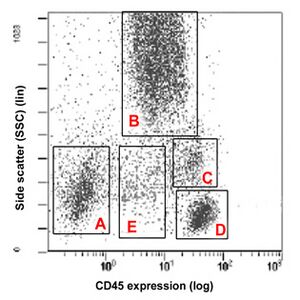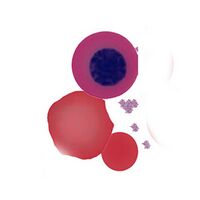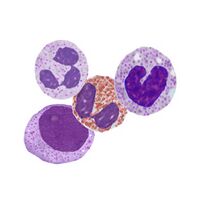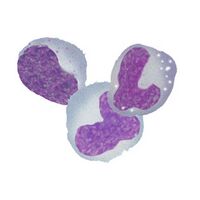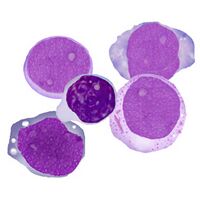CD45: Difference between revisions
From haematologyetc.co.uk
No edit summary |
No edit summary |
||
| (19 intermediate revisions by the same user not shown) | |||
| Line 5: | Line 5: | ||
:<span style="color:navy">'''Summary'''</span> | :<span style="color:navy">'''Summary'''</span> | ||
:CD45 is expressed by almost all mature or maturing leucocytes: | :CD45 is expressed by almost all mature or maturing leucocytes, often called: "leukocyte common antigen". | ||
:Usefully, the level of expression of CD45 differs according to both the cell type it is expressed on, and the maturation stage of that cell. Generally the expression for any cell type is quite consistent. This means that, when combined with other | :Usefully, the level of expression of CD45 differs according to both the cell type it is expressed on, and the maturation stage of that cell. Generally the expression for any cell type is quite consistent. This means that, when combined with other flow cytometry parameters (typically side-scatter of light) CD45 can be used to identify and select different leukocyte populations that can then be analysed individually: '''CD45 gating''' | ||
: | |||
| Line 17: | Line 15: | ||
:<span style="color:navy">'''Background'''</span> | :<span style="color:navy">'''Background'''</span> | ||
CD45 is a transmembrane protein that de-phosphorylates signalling molecules associated with immunological receptors to change their activation state. Expression is typically highest in cells actively involved in immune | CD45 is a transmembrane protein that de-phosphorylates signalling molecules associated with immunological receptors to change their activation state. Expression is therefore typically highest in cells actively involved in immune processes e.g. lymphocytes and monocytes and is lower in other populations including blast cells. | ||
:<span style="color:navy">'''Diagnostic Use'''</span> | :<span style="color:navy">'''Diagnostic Use'''</span> | ||
When combined with side scatter in two-dimensional dot plots CD45 expression can allow different leukocyte types to be separately identified and analysed. This can be very useful for analysis of individual populations of interest e.g. blast cells; lymphocytes etc. | When combined with side scatter in two-dimensional dot plots CD45 expression can allow different leukocyte types to be separately identified and analysed (CD45 gating). This can be very useful for analysis of individual populations of interest e.g. blast cells; lymphocytes etc. | ||
'''NOTE''' some cell types - particularly plasma cells are not easy to identify using CD45 gating since their expression of CD45 can be variable between cases and even within a single case. | |||
---- | |||
The appearance of CD45 plots varies with flow cytometer and also with laboratory preferences, however to illustrate how CD45 may be used to identify cells an example is given below: CD45 fluorescent intensity (log scale) on X-axis, Side scatter parameters linear scale on Y-axis. Cells then are separated according to the intensity of CD45 expression, but also according to side scatter parameters (irregularity of cytoplasm, nucleus, granularity etc) | |||
<gallery mode="nolines" widths="300px" heights="300px" border="1px" > | |||
file:CD45_populations.jpg|link={{filepath:CD45_populations.jpg}} | |||
</gallery> | |||
<gallery mode="nolines" widths="200px" heights="240px" border="1px" > | |||
file:CD45-PopA.jpg|'''Population A''' debris, platelets, unlysed red cells|link={{filepath:CD45-PopA.jpg}} | |||
file:CD45-PopB.jpg|'''Population B''' granulocytic cells|link={{filepath:CD45-PopB.jpg}} | |||
file:CD45-PopC.jpg|'''Population C''' monocytic cells|link={{filepath:CD45-PopC.jpg}} | |||
file:CD45-PopD.jpg|'''Population D''' lymphoid cells|link={{filepath:CD45-PopD.jpg}} | |||
file:CD45-PopE.jpg|'''Population E''' blast cells|link={{filepath:CD45-PopE.jpg}} | |||
</gallery> | |||
----- | ----- | ||
Latest revision as of 16:56, 13 July 2023
- Summary
- CD45 is expressed by almost all mature or maturing leucocytes, often called: "leukocyte common antigen".
- Usefully, the level of expression of CD45 differs according to both the cell type it is expressed on, and the maturation stage of that cell. Generally the expression for any cell type is quite consistent. This means that, when combined with other flow cytometry parameters (typically side-scatter of light) CD45 can be used to identify and select different leukocyte populations that can then be analysed individually: CD45 gating
- Background
CD45 is a transmembrane protein that de-phosphorylates signalling molecules associated with immunological receptors to change their activation state. Expression is therefore typically highest in cells actively involved in immune processes e.g. lymphocytes and monocytes and is lower in other populations including blast cells.
- Diagnostic Use
When combined with side scatter in two-dimensional dot plots CD45 expression can allow different leukocyte types to be separately identified and analysed (CD45 gating). This can be very useful for analysis of individual populations of interest e.g. blast cells; lymphocytes etc.
NOTE some cell types - particularly plasma cells are not easy to identify using CD45 gating since their expression of CD45 can be variable between cases and even within a single case.
The appearance of CD45 plots varies with flow cytometer and also with laboratory preferences, however to illustrate how CD45 may be used to identify cells an example is given below: CD45 fluorescent intensity (log scale) on X-axis, Side scatter parameters linear scale on Y-axis. Cells then are separated according to the intensity of CD45 expression, but also according to side scatter parameters (irregularity of cytoplasm, nucleus, granularity etc)
